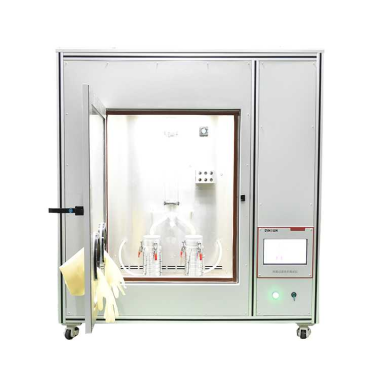時間: 人気:0タイムズ
The Mask Bacterial Filtration Efficiency Tester is used to measure the Bacterial Filtration Efficiency (BFE) of medical and surgical masks to determine their protective performance against airborne bacterial contamination. The tester is compatible with EN14683, ASTM F2100, ASTM F2101, YY 0469, and YY0969.
A bacterial suspension is pumped into a nebulizer, and the aerosol is propelled into an aerosol chamber. It is then delivered to two Anderson sieve samplers—one with a test sample and the other without—to compare the results.
The two Anderson sieve samplers enable simultaneous results with and without the test sample, minimizing bias. The machine features a built-in, clear, three-stage cleaning system (disinfectant solution, purified water, airflow) to ensure safety after testing.
1. Professional negative pressure biological safety cabinet technology to ensure the safety of operators and the environment.
2. High negative pressure working cabin, two-stage high-efficiency filter, 100% safe discharge.
3. Adopt two-way six-level Anderson precise sampling.
4. Built-in peristaltic pump with adjustable flow rate.
5. Special microbial aerosol generator, the flow rate of bacterial liquid spray is adjustable, and the atomization effect is good.
6. Industrial-grade large color touch screen control, the operation is simpler.
7. The control system adopts PLC + LabView control, high-intensity color touch screen 10 inches, USB interface, supports U disk data transfer;.
8. The safety cabinet has built-in LED lighting for easy observation.
9. Built-in ultraviolet disinfection lamp to enhance the protection effect.
10. The front switch type sealed glass door is convenient for operation and observation.
11. With operating software, it can be controlled and processed by computer.
12. Seamlessly connect the laboratory information management system.
① According to the medical surgical mask standard YY0469-2011. connect the two sampling ports of the Henderson pipe of the BFE system detector to the Anderson six-stage sampler.
② Load a 90mm diameter sampling plate into the Anderson six-stage sampler. Control the sampler's gas flow rate at 28.3L/min, the peristaltic pump flow rate at 0.180mL/min, the liquid supply time at 1min, the sampling time at 2min, and the system cleaning time at 1min. Perform a positive quality control test before testing.
③ After the sample test is complete, perform another positive quality control test. Then, collect an air sample from the aerosol chamber for 2min as a negative quality control. During this process, do not feed the bacterial suspension into the nebulizer.
④ Place the agar plate upside down in a (37±2)°C incubator and incubate for (48±2)h.
Then count the colony forming units (positive wells) of the bacterial particle aerosol and convert them to the number of possible impacting particles using a positive well conversion table. The formula for calculating the bacterial filtration efficiency of a mask is: BFE = (C-T)/C × 100% (where C is the average value of the positive quality control; T is the sum of the sample counts). The "Technical Requirements for Medical Surgical Masks" (YY 0469-2011) stipulates that the bacterial filtration efficiency should be greater than 95%.
Medical surgical masks can effectively prevent the spread of pathogens and protect healthy people. BFE is expressed as the percentage of aerosols filtered by the medical surgical mask filter material at a specified flow rate and is an important parameter for evaluating the performance of medical surgical masks [4.5]. The BFE system generates bioaerosols in an artificially controlled environment and evaluates the protective performance and safety of medical surgical masks by calculating the microbial aerosol filtration efficiency. The system program has three modes: purification, maintenance, and testing. This program not only ensures the accuracy of experimental results but also ensures the safety of experimental personnel, experimental samples, and the experimental environment.
If water droplets are present in the water separator and aerator, loosen the knob at the bottom of the water separator and air filter to drain the water. After draining, re-tighten the knob. The HEPA filter included with the detector is a consumable item and should normally be replaced once a year.
Daily Maintenance: This detector should be used in a well-ventilated, dry, dust-free environment free from strong electromagnetic interference. The power cord may become loose or disconnected after long-term use. Inspect the power cord before each use to ensure it is free of damage, cracks, or disconnections.
Clean the instrument with a soft cloth and a neutral detergent. Before cleaning, disconnect the power cord. Do not use volatile substances such as thinners and benzene to clean the instrument, as these may change the color of the instrument housing, erase the markings on the housing, or blur the touchscreen display.

会社電話
+86-21-6420 0566
営業時間
月曜日から金曜日
携帯電話:
13816217984
メール:
info@qinsun-lab.com
